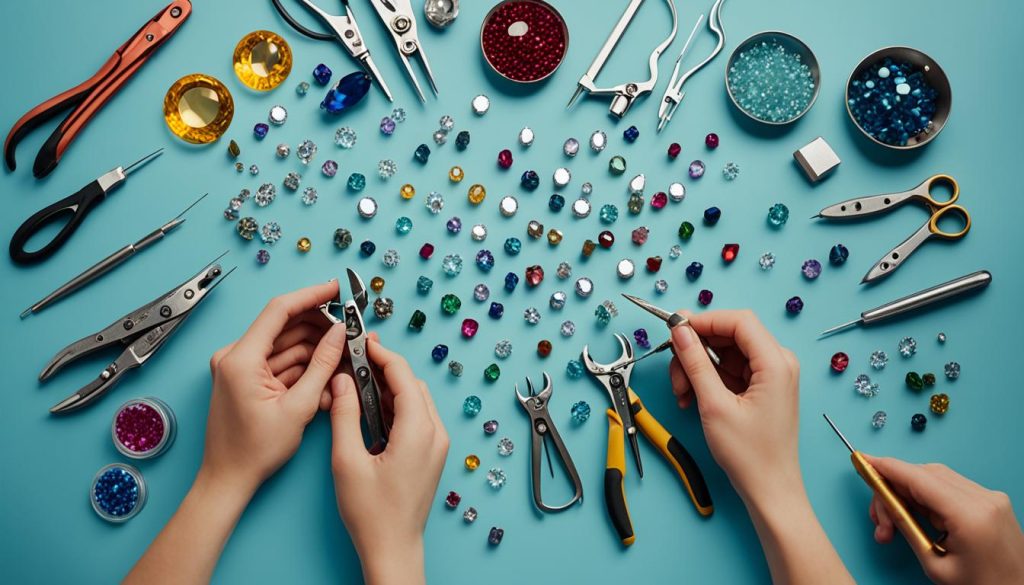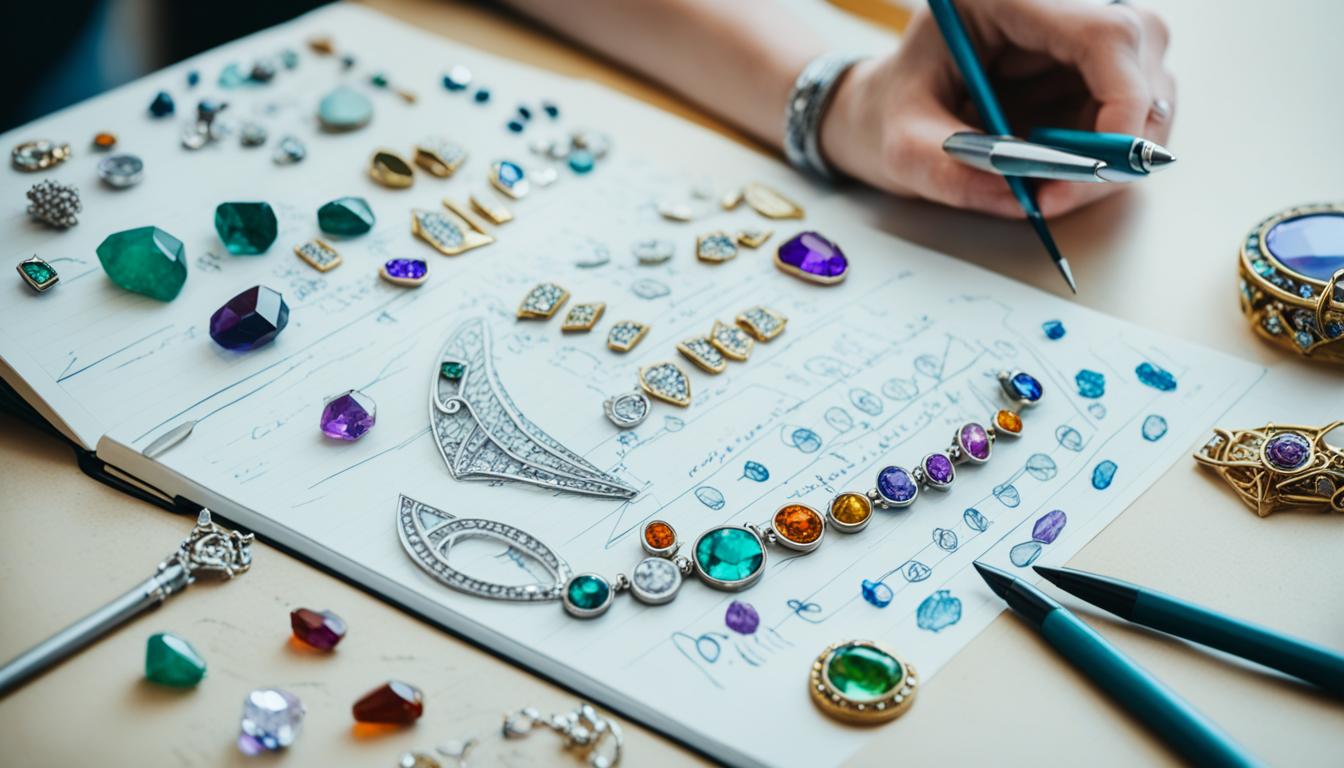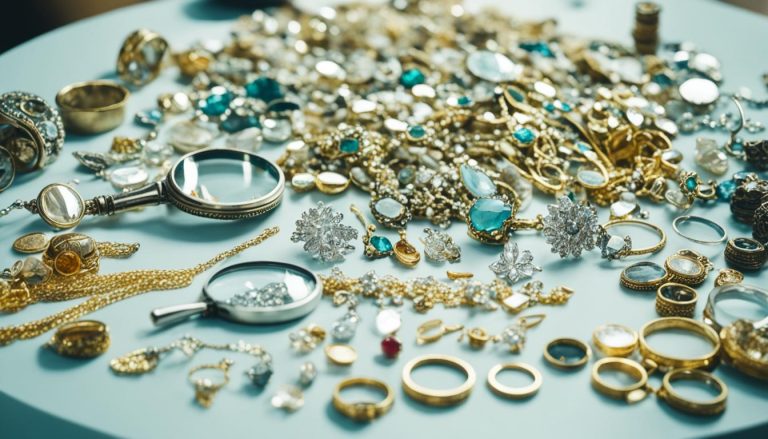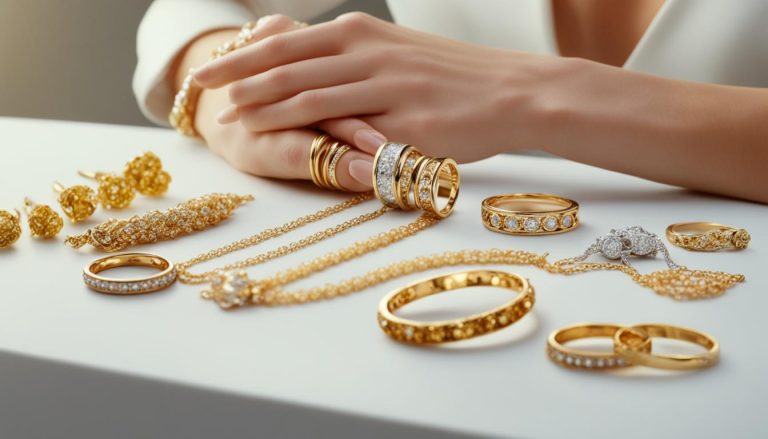If you have a passion for creativity, an eye for design, and a love for accessories, becoming a jewellery designer might be the perfect career path for you. Jewellery designers are the masterful creators behind the intricate patterns and stunning accessories that adorn individuals around the world. From sketching designs to crafting personalized pieces, jewellery designers are the architects of beauty and elegance.
To embark on this rewarding journey, you need to understand the steps involved in becoming a jewellery designer. From education to gaining experience and establishing your own business, each step plays a crucial role in shaping your career. In this comprehensive guide, we will walk you through the process, helping you unleash your creativity and carve your niche in the jewellery design industry.
Key Takeaways:
- Embark on a creative and rewarding career as a jewellery designer
- Discover the steps involved in becoming a successful jewellery designer
- Unleash your creativity and create exquisite designs for personalised accessories
- Gain the necessary education, experience, and skills to excel in the industry
- Explore the potential for career growth and job opportunities as a jewellery designer
What Does a Jewellery Designer Do?
A jewellery designer is responsible for a diverse range of tasks that contribute to the creation of exquisite accessories. Their responsibilities and design tasks vary depending on their workplace environment and the specific requirements of each bespoke order. Here are some key responsibilities and tasks that jewellery designers undertake:
- Sketching Designs: Jewellery designers use either paper or digital software to create detailed sketches of their designs. These sketches serve as blueprints for the final product and allow the designer to visualize the piece before it is brought to life.
- Appraising Gemstones: Evaluating the quality and value of gemstones is another important responsibility of a jewellery designer. They assess the clarity, cut, color, and carat weight of gemstones to ensure they meet the desired standards for each design.
- Wax Model Analysis: Jewellery designers analyze wax models to assess the shape and proportions of the piece. This step allows them to make any necessary adjustments or modifications to ensure the final product meets the client’s expectations.
- Executing Casting: Casting is the process of pouring molten metal into a mold to create the jewellery piece. Jewellery designers oversee this stage to ensure that the casting is executed accurately and according to the design specifications.
- Polishing and Refining: Once the metal is cast, jewellery designers refine and polish the piece to achieve a smooth and lustrous finish. This step requires precision and attention to detail to bring out the beauty of the design.
- Collaborating with Craftsmen: Jewellery designers often collaborate with skilled craftsmen to translate their designs into physical pieces. They work closely with these artisans to ensure that the final product reflects their original vision.
The above tasks represent a general overview of a jewellery designer’s responsibilities. However, the specific tasks may vary depending on the type of jewellery being created and the unique requirements of each client.
What Education Do You Need to Become a Jewellery Designer?
While a degree is not strictly required, many aspiring jewellery designers opt for formal education to learn the tools of the trade. They can earn an associate’s or bachelor’s degree in gemology, jewellery design, accessories design, or a related field. These programs help them develop their design skills, learn about gemstones and materials, gain experience with advanced software and equipment, and connect with industry professionals.
4 Essential Steps to Become a Jewellery Designer
To become a jewellery designer and embark on a rewarding career in the industry, there are four essential steps you need to follow:
- Gain Experience: Start by gaining practical experience in the industry through internships or entry-level positions. This hands-on experience will allow you to learn about the different aspects of jewellery design and gain valuable insights into the industry.
- Create a Portfolio: Building a portfolio of your designs is crucial to showcase your skills and creativity to potential clients or employers. Include a variety of your best designs, highlighting your unique style and attention to detail.
- Invest in Further Education: Consider investing in further education or specialized training to enhance your knowledge and techniques. This can include taking advanced courses in jewellery design, gemology, or specific techniques such as stone setting or metalworking.
- Grow Your Professional Network: Expand your professional network by attending industry events, joining jewellery design organizations, and collaborating with fellow designers. Networking can lead to new opportunities, partnerships, and valuable connections within the industry.
By following these steps, you will be on your way to becoming a successful jewellery designer and establishing yourself in this creative and competitive field.
| Step | Description |
|---|---|
| Step 1 | Gain Experience |
| Step 2 | Create a Portfolio |
| Step 3 | Invest in Further Education |
| Step 4 | Grow Your Professional Network |
Jewellery Designer Job Outlook
The job outlook for jewellery designers is highly promising, propelled by the ever-evolving landscape of fashion trends and consumer preferences. As the demand for personalized accessories continues to grow, there is an increasing need for skilled jewellery designers who can create unique and authentic pieces that resonate with individuals’ style and personality.
Digital platforms and e-commerce have revolutionized the jewellery design industry, expanding its reach and market potential. Online marketplaces provide jewellery designers with a global platform to showcase and sell their creations, reaching customers around the world. This digital shift has opened up numerous opportunities for designers to connect with a wider audience and establish their brand presence in the industry.
Collaborations with influencers, celebrities, and brands have become a cornerstone of the jewellery design industry. By partnering with well-known figures and established brands, designers can gain exposure, credibility, and access to new markets. Collaborative efforts foster innovation and push the boundaries of design, driving the demand for imaginative and cutting-edge jewellery creations.
| Jewellery Designer Job Outlook | Jewellery Design Industry Trends |
|---|---|
|
|
As the industry continues to evolve, jewellery designers who stay attuned to the latest trends and adapt to changing consumer preferences will thrive. It is essential for designers to incorporate technology into their design process, whether it be through 3D modeling software or utilizing advanced manufacturing techniques like laser cutting and additive manufacturing. Additionally, there is a growing emphasis on sustainable and ethical practices, with consumers seeking jewellery made from responsibly sourced materials and produced through environmentally friendly processes.
“The job outlook for jewellery designers is bright. With the right blend of creativity, technical skills, and business acumen, aspiring designers can carve a successful career in this dynamic industry.”
By keeping a finger on the pulse of industry trends, jewellery designers can predict and cater to evolving consumer demands. Exploring unconventional materials, pushing boundaries in design, and experimenting with innovative techniques enable designers to create truly exceptional and captivating pieces that stand out in a crowded market.
Jewellery Designer Salary Outlook
When it comes to the salary outlook for jewellery designers, several factors come into play, including experience, location, and the type of employer. The earning potential for jewellery designers can vary significantly, so let’s take a closer look at what you can expect at different stages of your career.
Entry-Level Salary Range
As a junior jewellery designer just starting out, your salary will typically fall within a certain range per year. The exact figures can vary depending on various factors, but the entry-level salary provides a starting point for your career in this field.
Note: The exact salary range may vary depending on the country or region.
Earning Potential with Experience
As you gain more experience and expertise as a jewellery designer, your earning potential increases. This growth in earnings is a result of your improved skills, reputation, and ability to take on more complex and higher-profile projects.
Note: The earning potential can differ significantly based on your location, the demand for jewellery designers, and the type of clients you work with.
Self-Employed vs. Established Brands
The salary outlook for jewellery designers can also vary depending on whether you work as a self-employed designer or as part of an established brand or company. Self-employed designers have the potential to earn higher incomes through their own unique creations, client base, and pricing structures.
On the other hand, working for an established brand or company may offer more stability and a regular salary, but the earning potential may be influenced by factors such as the brand’s reputation, market demand, and the specific position within the organization.
Note: Established brands may offer additional benefits such as bonuses, commissions, or profit-sharing opportunities.
The salary outlook for jewellery designers is influenced by various factors, including experience, location, and the type of employer. As you progress in your career and gain more experience, your earning potential will increase. Whether you choose to work as a self-employed designer or for an established brand, the salary outlook can be promising in this creative and rewarding field.
What Skills Do You Need to Become a Jewellery Designer?
To succeed as a jewellery designer, you need to possess a diverse range of skills that allow you to bring your creative vision to life. Here are the essential skills that will set you apart in your jewellery design career:
- Artistic Creativity: A keen sense of artistic creativity is fundamental for jewellery designers. This skill enables you to envision and design unique and aesthetically pleasing pieces that captivate the attention of potential customers.
- Attention to Detail: Attention to detail is crucial in jewellery design. You must have a keen eye for intricate details, as even the smallest element can greatly impact and enhance the overall design of a piece.
- Manual Dexterity: Practical skills and manual dexterity are essential for jewellery designers. Working with small components and delicate materials requires precision and a steady hand.
- Good Eye for Design: A good eye for design helps you understand visual aesthetics and balance. Being able to harmonize various elements such as color, form, and texture is crucial in creating visually appealing jewellery.
- Understanding of Materials, Gemstones, and Metals: A strong understanding of different materials, gemstones, and metals is essential in jewellery design. Knowledge of their properties, characteristics, and compatibility will enable you to make informed decisions while creating pieces.
- Proficiency in Design Software: In today’s digital age, proficiency in design software is highly beneficial. Software programs such as CAD (Computer-Aided Design) allow you to create detailed, precise, and realistic virtual models of your designs.
- Sketching and Visualization: The ability to sketch and communicate your ideas visually is vital in jewellery design. It allows you to present your concepts to clients, colleagues, or craftsmen effectively.
- Problem-Solving: Problem-solving skills are essential in overcoming design challenges and finding innovative solutions. Being able to think critically and adapt to unexpected situations will help you create unique and high-quality designs.
- Time Management: Effective time management is crucial in meeting deadlines and delivering designs on time. Organizing your tasks, setting priorities, and efficiently allocating your time are skills that will contribute to your success as a jewellery designer.
- Ability to Work in a Team: Collaborating with craftsmen, clients, and other professionals is common in the jewellery industry. The ability to work cohesively in a team and effectively communicate your ideas is important for successful project execution.
As a jewellery designer, honing these skills will make you a sought-after professional in the industry, setting you on a path towards a successful and fulfilling career.
Image:

Step 1: Understand the Basics
Before embarking on a career as a jewellery designer, it is crucial to have a strong foundation in the basics of jewellery making. This includes familiarizing yourself with various types of jewellery and the materials used in their creation.
Types of Jewellery
- Rings
- Necklaces
- Bracelets
- Earrings
- Brooches
- Cufflinks
These are just a few examples of the diverse range of jewellery types that you can create as a designer. Each type requires its own unique design considerations and craftsmanship techniques.
Materials Used in Jewellery Making
Jewellery designers utilize a wide variety of materials to bring their creations to life. Understanding the properties and characteristics of these materials is essential for crafting high-quality jewellery.
- Precious metals, such as gold, silver, and platinum
- Gemstones, including diamonds, rubies, sapphires, and emeralds
- Organic materials, like pearls, shells, and wood
- Glass, which can be shaped and colored to create unique designs
- Ceramics, offering a versatile medium for innovative jewellery
- Enamels, used to add vibrant colors and intricate patterns
By familiarizing yourself with the different types of jewellery and materials used in jewellery making, you will develop a solid foundation for your career as a jewellery designer.
Step 2: Educational Path
To pursue a career as a jewellery designer, you have several educational paths to choose from. These pathways will equip you with the necessary skills and knowledge to excel in the field. Whether you prefer hands-on training or a formal degree, there are options available to suit your learning style and goals.
- Jewellery Making Courses: Taking jewellery design courses is an excellent way to gain practical skills and insights into the craft. These courses often cover a range of topics, including metalworking techniques, stone setting, surface treatments, wire wrapping, and basic jewellery design. They are typically shorter in duration and provide a focused learning experience.
- Formal Jewellery Design Degrees: Earning an associate’s or bachelor’s degree in jewellery design or a related field can provide a comprehensive understanding of the industry and a solid foundation in design principles. These formal education programs offer a structured curriculum that covers various aspects of jewellery design, gemology, materials, and manufacturing processes. They also provide opportunities for hands-on learning and often include internships or capstone projects.
- Online Learning Platforms: In the digital age, online learning platforms have become increasingly popular for acquiring new skills and knowledge. Many reputable institutions and industry experts offer online courses specifically tailored to jewellery design. These courses are flexible, allowing you to learn at your own pace and from the comfort of your own home. They cover a wide range of topics and provide access to valuable resources and mentorship.
Regardless of the educational path you choose, the key is to invest in your learning and acquire the necessary skills to succeed as a jewellery designer. Let’s explore the benefits of each educational option in more detail.
Step 3: Gain Experience
Gaining hands-on experience is crucial for aspiring jewellery designers. This step allows you to refine your skills, learn from experienced professionals, and understand the inner workings of the industry. There are several pathways you can take to gain valuable experience in jewellery design.
Apprenticeships
Apprenticeships provide a unique opportunity to learn directly from experienced jewellers. Through an apprenticeship, you can acquire essential skills and knowledge while working alongside professionals in the field. This hands-on training allows you to develop your craftsmanship and gain insights into the intricate art of jewellery making.
Internships
Internships are another valuable way to gain practical experience in jewellery design. They offer a chance to work in established jewellery studios or companies, where you can learn from industry experts and collaborate on real projects. Internships provide firsthand exposure to design processes, client interactions, and the overall dynamics of the industry. They also offer valuable networking opportunities and the chance to build relationships with professionals in the field.
Entry-Level Jobs
Entry-level positions in jewellery design allow you to further develop your skills while gaining a comprehensive understanding of the day-to-day operations of a jewellery business. These jobs may include roles such as design assistants, production associates, or sales associates in jewellery stores. By working in these roles, you can expand your knowledge of the industry, strengthen your technical abilities, and gain valuable insights into the market.
Remember, the more experience you gain, the more equipped you’ll be to create exceptional jewellery designs and meet the demands of clients. Seek out apprenticeships, internships, or entry-level job opportunities in the jewellery industry to accelerate your growth as a jewellery designer and pave the way for a successful career.

Step 4: Grow Your Skills and Network
As a jewellery designer, continuous skill development and networking are crucial for your professional growth. By actively seeking out opportunities to enhance your abilities and connect with others in the industry, you can stay updated on the latest trends and expand your reach.
Attend Jewellery Making Workshops
To learn new techniques and explore innovative materials, consider attending jewellery making workshops. These workshops provide a hands-on learning experience and allow you to collaborate with experienced professionals. By participating in these workshops, you can broaden your skill set and gain inspiration for your own designs. Explore workshops offered by renowned jewellers and educational institutions to find ones that align with your interests and goals. Here are some notable workshops:
- Mastering Gemstone Setting Techniques: A workshop focused on various gemstone setting techniques, including prong, bezel, and pavé settings. Led by Gemstone Designs.
- Exploring Artistic Metalworking: A workshop that delves into advanced metalworking techniques, such as soldering, forging, and engraving. Taught by The Metalworking Institute.
- Introduction to Contemporary Jewelry Design: A beginner-friendly workshop that introduces modern jewellery design concepts and techniques. Offered by The Design Studio.
Attending jewellery making workshops allows you to expand your skill set, experiment with new techniques, and gain insights from industry experts. Stay updated on workshop dates and locations by following industry publications, social media groups, and relevant websites.
Networking Events for Jewellery Designers
Networking events provide invaluable opportunities to connect with other professionals in the jewellery industry, strengthen relationships, and explore potential collaborations. These events can range from trade shows and conferences to industry-specific gatherings and exhibitions. By attending these events, you can:
- Expand your professional network: Meet like-minded individuals, fellow jewellery designers, and potential clients or collaborators who can contribute to your career growth.
- Stay updated on industry trends: Gain insights into the latest design trends, techniques, and market demands by engaging in conversations and attending panel discussions.
- Promote your work: Showcase your portfolio, exchange ideas, and receive feedback from experts and peers within the industry.
Here are some highly recommended networking events for jewellery designers:
- Gemstone Expo: An annual trade show where jewellery designers, gemstone suppliers, and retailers gather to showcase their products and network. Held in major cities worldwide.
- Jewellery Design Conference: A multi-day conference featuring industry-leading speakers, workshops, and networking sessions. Hosted by the International Association of Jewellery Designers.
- Artisan Jewellery Fair: A curated exhibition highlighting the work of independent jewellery designers. Offers an opportunity to connect directly with designers and potential clients.
Attending these events allows you to develop meaningful connections, gain industry insights, and increase the visibility of your own brand. Stay updated on upcoming events through industry publications, social media groups, and professional organizations.
Step 5: Start Your Own Business
For those aspiring to start their own jewellery design business, there are certain steps to consider. These include creating a business plan, securing funding, and marketing your jewellery. A well-developed business plan helps outline your goals, target market, and financial projections. Securing funding can be done through various means, such as personal savings, loans, or partnerships. Effective marketing strategies, such as showcasing your designs on digital platforms, participating in exhibitions, and collaborating with influencers, can help grow your business.
Starting a jewellery design business requires careful planning and execution. Follow these steps to set yourself up for success:
- Create a business plan: Your business plan serves as a roadmap for your jewellery design business. It outlines your goals, target market, competitive analysis, financial projections, marketing strategies, and more. A well-crafted business plan helps you stay organized and focused as you embark on your entrepreneurial journey. Here are some key elements to include in your business plan:
- Executive summary: A brief overview of your business, its mission, and goals
- Market analysis: Research on the jewellery market, target audience, and competitors
- Product line: Description of the types of jewellery you will design and create
- Marketing and sales strategy: How you plan to promote and sell your jewellery
- Financial projections: Estimated startup costs, sales forecasts, and profit margins
- Operations plan: How you will manage production, inventory, and logistics
- Secure funding: Starting a jewellery design business may require initial investment for equipment, materials, marketing, and other expenses. Consider your options for funding, such as:
- Personal savings: Use your own savings to fund your business
- Loans: Explore small business loans or lines of credit from banks or financial institutions
- Partnerships: Consider partnering with investors who are interested in supporting your business
- Build your brand: Establishing a strong brand identity is essential for success in the jewellery industry. Develop a brand that reflects your unique design style, values, and target audience. Consider the following aspects:
- Logo and visual identity: Create a distinctive logo and visual elements that represent your brand
- Website and online presence: Build a professional website to showcase your designs and attract customers
- Social media: Utilize social media platforms to engage with your target audience and promote your jewellery
- Photography and packaging: Invest in high-quality product photography and attractive packaging to enhance the perceived value of your jewellery
- Market your jewellery: Effective marketing is essential for attracting customers and growing your jewellery design business. Consider the following strategies:
- Showcasing your designs on digital platforms: Create an online portfolio or e-commerce website to display and sell your jewellery
- Participating in exhibitions and trade shows: Showcase your jewellery at local and international jewellery events to gain exposure and connect with potential customers and industry professionals
- Collaborating with influencers: Partner with influencers or bloggers in the fashion and jewellery industry to promote your designs to a wider audience
- Word-of-mouth marketing: Encourage satisfied customers to share their positive experiences and recommend your jewellery to others
Starting your own jewellery design business requires dedication, creativity, and a strong entrepreneurial spirit. By following these steps and continuously refining your skills and business strategies, you can turn your passion for jewellery design into a successful venture.
Conclusion
Becoming a jewellery designer is an exciting journey that requires a combination of education, experience, and skill development. By following the steps outlined in this guide, you can refine your skills, build your portfolio, and establish yourself in the industry. The path to becoming a jewellery designer may vary, but pursuing formal education, gaining hands-on experience, and networking with industry professionals are key steps on your journey to success.
Start by understanding the basics of jewellery making and familiarize yourself with the different types of jewellery and materials used. Consider pursuing an educational path through jewellery making courses or earning a degree in jewellery design. Gain practical experience through apprenticeships, internships, or entry-level jobs in the industry.
To continue growing as a jewellery designer, attend workshops to learn new techniques and materials, and participate in networking events to connect with industry professionals. Consider joining professional organizations to access valuable resources and networking opportunities. If you aspire to start your own jewellery design business, create a business plan, secure funding, and implement effective marketing strategies to showcase your unique designs.
With dedication and perseverance, you can carve a successful career as a jewellery designer. Embrace your creativity, hone your skills, and seize opportunities to showcase your unique style. Whether you work for established brands or start your own business, the world of jewellery design is waiting for you to leave your mark.







+ There are no comments
Add yours